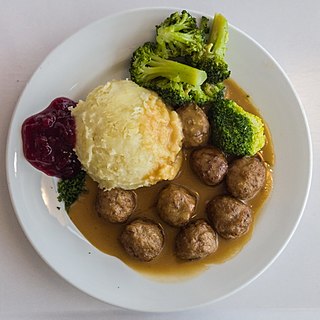
Swedish cuisine is the traditional food of Sweden. Due to Sweden's large north-to-south expanse, there are regional differences between the cuisine of North and South Sweden.

Potato pancakes are shallow-fried pancakes of grated or ground potato, matzo meal or flour and a binding ingredient such as egg or applesauce, often flavored with grated garlic or onion and seasonings. They may be topped with a variety of condiments, ranging from the savory, to the sweet, or they may be served plain. The dish is sometimes made from mashed potatoes to make pancake-shaped croquettes. Some variations are made with sweet potatoes.
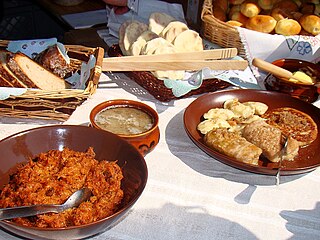
Polish cuisine is a style of food preparation originating in and widely popular in Poland. Due to Poland's history, Polish cuisine has evolved over the centuries to be very eclectic, and shares many similarities with other national cuisines. Polish cooking in other cultures is often referred to as à la polonaise.

The cuisine of New York City comprises many cuisines belonging to various ethnic groups that have entered the United States through the city. Almost all ethnic cuisines are well represented in New York, both within and outside the various ethnic neighborhoods.

Delancey Street is one of the main thoroughfares of New York City's Lower East Side in Manhattan, running from the street's western terminus at the Bowery to its eastern end at FDR Drive, connecting to the Williamsburg Bridge and Brooklyn at Clinton Street. It is an eight-lane, median-divided street, which is west of Clinton Street, and a service road for the Williamsburg Bridge east of Clinton Street. West of Bowery, Delancey Street becomes Kenmare Street, which continues as a four-lane, undivided street to Lafayette Street.

Ukrainian cuisine is the collection of the various cooking traditions of the people of Ukraine, one of the largest and most populous European countries. It is heavily influenced by the rich dark soil from which its ingredients come, and often involves many components. Traditional Ukrainian dishes often experience a complex heating process – "at first they are fried or boiled, and then stewed or baked. This is the most distinctive feature of Ukrainian cuisine".

Jewish cuisine refers to the worldwide cooking traditions of the Jewish people. During its evolution over the course of many centuries, it has been shaped by Jewish dietary laws (kashrut), Jewish festivals and holidays, and traditions centred around Shabbat. Jewish cuisine is influenced by the economics, agriculture, and culinary traditions of the many countries where Jewish communities have settled and varies widely throughout the entire world.
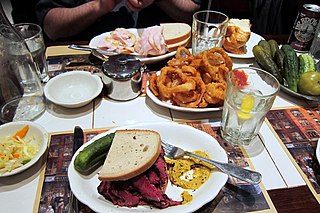
The Second Avenue Deli is a certified-kosher Jewish delicatessen in Manhattan, New York City. It was located in the East Village until December 2007, when it relocated to 162 East 33rd Street in Murray Hill. In August 2011, it opened a second branch at 1442 First Avenue on the Upper East Side. In November 2017, it opened a cocktail lounge called 2nd Floor above its Upper East Side branch.

Belarusian cuisine refers to the culinary traditions native to Belarus. It shares many similarities with cuisines of other Eastern, Central and Northeastern European countries, based predominantly on meat and various vegetables typical for the region.

Cacciucco is an Italian fish stew native to the western coastal towns of Tuscany. It is especially associated with the port city of Livorno, in Tuscany, and the town of Viareggio north of it.

Jacob "Little Augie" Orgen was a New York gangster involved in bootlegging and labor racketeering during Prohibition.

Jacob "Gurrah" Shapiro was a New York mobster who, with his partner Louis "Lepke" Buchalter, controlled industrial labor racketeering in New York for two decades and established the Murder, Inc. organization.

Soup is a primarily liquid food, generally served warm or hot, that is made by combining ingredients of meat or vegetables with stock, milk, or water. Hot soups are additionally characterized by boiling solid ingredients in liquids in a pot until the flavors are extracted, forming a broth. Soups are similar to stews, and in some cases there may not be a clear distinction between the two; however, soups generally have more liquid (broth) than stews.

Onion rolls are a roll of Ashkenazi Jewish origin similar to a bun, that is made of a soft, slightly sweet dough similar to challah, containing dried onions throughout which create its signature flavor. It is often topped with dried onions, and occasionally poppy seeds.

The Clinton Street Baking Company & Restaurant (CSBC) is an American bakery and restaurant. It is located at 4 Clinton Street, on the Lower East Side of Manhattan, New York.

American Jewish cuisine comprises the food, cooking, and dining customs associated with American Jews. It was heavily influenced by the cuisine of Jewish immigrants who came to the United States from Eastern Europe around the turn of the 20th century. It was further developed in unique ways by the immigrants and their descendants, especially in New York City and other large metropolitan areas of the northeastern U.S.
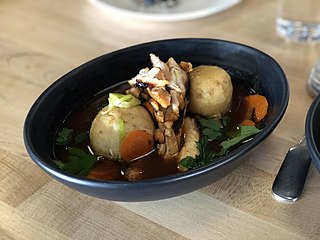
Ashkenazi Jewish cuisine is an assortment of cooking traditions that was developed by the Ashkenazi Jews of Central, Eastern, Northwestern and Northern Europe, and their descendants, particularly in the United States and other Western countries.

A Jewish deli, also known as a Jewish delicatessen, is a restaurant that serves various traditional dishes of Ashkenazi Jewish cuisine. Best known for their robust sandwiches, such as pastrami on rye, they also specialize in traditional Jewish diaspora soups, such as matzo ball, and other ethnically-rooted dishes. Betraying their roots as retail delicatessens, most also sell a selection of their products, such as sliced meats by the pound, prepared salads, and pickles, and do a thriving take-out trade.
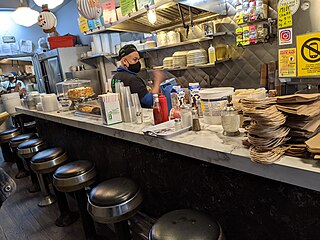
A Jewish dairy restaurant, Kosher dairy restaurant, dairy lunchroom or dairy deli is a type of vegetarian kosher restaurant, luncheonette or eat-in diner in Ashkenazi Jewish cuisine, particularly American Jewish cuisine and the cuisine of New York City.





















